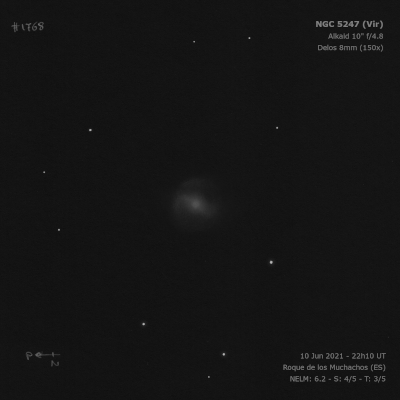
William Herschel discovered NGC 5247 = H II-297 = h1649 on 7 Feb 1785 (sweep 369) and logged "pF, L, mbM." A later observation on 7 Feb 1787 (sweep 732) reads "pB, vL, the greatest part of it vF, unequally bright almost like two joined, the smaller being north preceding [perhaps a spiral arm?]." On sweep 354, John Herschel recorded "vF; vL; psb to a brighter kind of nebula; a good type of its class. It loses itself quite imperceptibly. Diam of the faint neb = 2'; of the brighter part or nucl = 10 or 15". (See fig 39.)".
William Lassell observed this galaxy with his 48-inch from Malta on 20 May 1862 and called it "a very faint spiral Nebula". His sketch (Plate VII, Fig. 29, in Memoirs of the Royal Astronomical Society, Vol 36) shows a graceful S-shaped spiral with two long arms opening widely from a small nucleus. The NGC description "2 branched spiral" refers to Lassell's sketch. Joseph Turner observed it on 8 May 1878 with the 48-inch Great Melbourne Telescope with a 6-day moon in the sky and noted mottling, but no spiral structure.
400/500mm - 17.5" (5/30/92): moderately bright, large, slightly elongated 4:3 SW-NE, about 4'x3', sharp concentration with a very weakly concentrated halo which fades into the background. Unusual appearance as suddenly rises to very small bright core 20"-30" diameter. Spiral structure not seen.
900/1200mm - 48" (5/14/12): I was amazed at the beauty of this face-on spiral with two well-defined spiral arms containing numerous HII knots and a third faint arm! The galaxy is sharply concentrated with an extremely bright round core, ~30" diameter. The slightly brighter and longer southern arm was attached at the north end of the core and winded gracefully counterclockwise for nearly 270°, terminating on the WSW side of the galaxy, 2.4' from center. The arm displayed a high-contrast and was relatively narrow and sharply defined. It contained two knots and brighter segments. It broadened slightly as it unwound on the south side and appeared slightly mottled. The brightest HII knot was 10" in diameter and situated slightly further out, 1.9' SW of center. Beyond this point, the last portion of the arm dimmed and ended at another 8" knot at the tip, 2.4' WSW of center. The northern arm is attached on the south side of the core and winds counterclockwise to the north, though only curves gently. A fairly bright knot (possibly double) is situated along this arm 1.4' NNW of center. Another fainter knot is at the north tip of the arm, 1.8' from center. A third, vaguely defined arm emerges to the south of the core and unwinds counterclockwise to the west. A mag 16.5 star marks the tip of this arm.
Notes by Steve Gottlieb